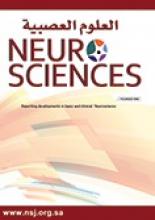To the Editor
We have read with interest the study by Mohammed et al on the incidence of autism in high risk neonatal follow up.1 The authors did well in addressing 4 limitations of their study. I presume that the following 3 points might be additionally contributory.
First, the authors addressed that the diagnosis of autism spectrum disorders (ASDs) cases was based on Diagnostic and Statistical Manual of Mental Disorders, Fourth Edition (DSM-IV) criteria released in 1994. The new revision for ASDs in the DSM -Fifth Edition (DSM-V) that was released in May 2013 represents a shift from the DSM-IV, Text Revision (DSM-IV-TR). The new diagnostic criteria encompasses previous elements from the diagnosis of autistic disorder, Asperger disorder, childhood disintegrative disorder, and pervasive developmental disorder-not otherwise specified. An additional change to the DSM-V includes synthesizing the section on social and communication deficits into one domain.2 Accordingly, there have been some concerns on the impact that this will have on diagnostic outcomes. The recently published evaluation of the this new version revealed that the rate of ASDs diagnosis was significantly lower under the recently implemented DSM-V compared to DSM-IV.3 I presume that the implementation of DSM-V in the studied population might alter the estimated total incidence of ASDs [4.7% (95% CI: 1.7%-10.8%)] reported by Mohammed et al1 and, consequently the relevant risk factors associated with a higher likelihood of ASDs.
Second, the authors mentioned in the methodology that all patients in the High Risk Neonatal Follow up Program (HRNFP) had very low birth weight (100%) and that the gestational age was ≤29 weeks in 80% of ASDs patients. Screening of the studied population for developmental disorders was carried out at the corrected age of 18 and 36 months.1 Generally, ASDs patient are diagnosed around the age of 4 years. There are growing concerns regarding the stability of ASDs diagnosis as early as 18 months of age. In a recently published study, it was investigated whether the age of ASDs diagnosis was related to the severity of children’s ASDs symptoms or developmental delays. The participants (n=381) were seen at 3 ages: 18 months, 24 months, and 3 years. The ASDs symptoms, general development, and adaptive functioning were assessed at each time point. Twenty-three children were diagnosed with ASDs at 18 months and a total of 61 at 24 months. Of these diagnoses, 19/23 (82.6%) and 56/61 (91.8%), respectively, were confirmed independently at 3 years. However, 45 children were diagnosed with ASDs at 3 years who had not been identified at earlier visits. Children diagnosed at 18 months in comparison to those diagnosed at 24 months had less advanced language and adaptive skills at 18 months. Children not diagnosed with ASDs until 3 years, compared with those diagnosed earlier, had more advanced language and adaptive skills and milder ASDs symptoms.4 Similar concerns were raised considering the stability and change in early ASDs risk in preterm babies. In a recently published study, the stability and change in early ASDs risk were evaluated in a cohort of 99 preterm infants (≤34 weeks of gestation) using the Autism Observation Scale for Infants (AOSI) at 8 and 12 months and the Autism Diagnostic Observation Schedule-Toddler Module (ADOS-T) at 18 months. A total of 21 infants were identified at risk by AOSI at 8 months, and 9 were identified at risk at 12 months, including 4 children who were not previously identified. At 18 months, eight children were identified at risk for ASDs using ADOS-T, only half of whom had been identified using the original AOSI cutoffs.5 Accordingly, I presume that the aforementioned 2 growing concerns might cast suspicions on the accuracy of the data addressed in Mohammed et al’s study.1
Third, despite all limitations, Mohammed et al’s study1 still represents a worthy work. To have a better idea on ASDs estimate and relevant risk factors within HRNFP, which reflects ASDs spectrum in Kingdom of Saudi Arabia, I suggest employing DSM-V criteria in a novel prospective study involving a large study population and extended study period as well as numerous risk factors, notably gender, birth weight, gestational age, maternal and paternal age, family history of ASDs or other neuropsychiatric disorders, socioeconomic status, perinatal events, birth order, and neonatal anemia and jaundice.
Reply from the Author
Regarding the first issue, we started our study before the release of DSM-V. For the second concern, the American Academy of Pediatrics recommends that autism-specific standardized screening be administered at the 18 and 24 month health maintenance visits.6 The Modified Checklist for Autism in Toddlers Revised with Follow-Up (M-CHAT-R/F) is valid for use between 16 and 30 months of age.7 Currently, we are running study on risk factors for ASD, recruiting larger numbers and displaying comparisons regarding the incidence in children with no low birth weight or other complications.
- Copyright: © Neurosciences
Neurosciences is an Open Access journal and articles published are distributed under the terms of the Creative Commons Attribution-NonCommercial License (CC BY-NC). Readers may copy, distribute, and display the work for non-commercial purposes with the proper citation of the original work.






